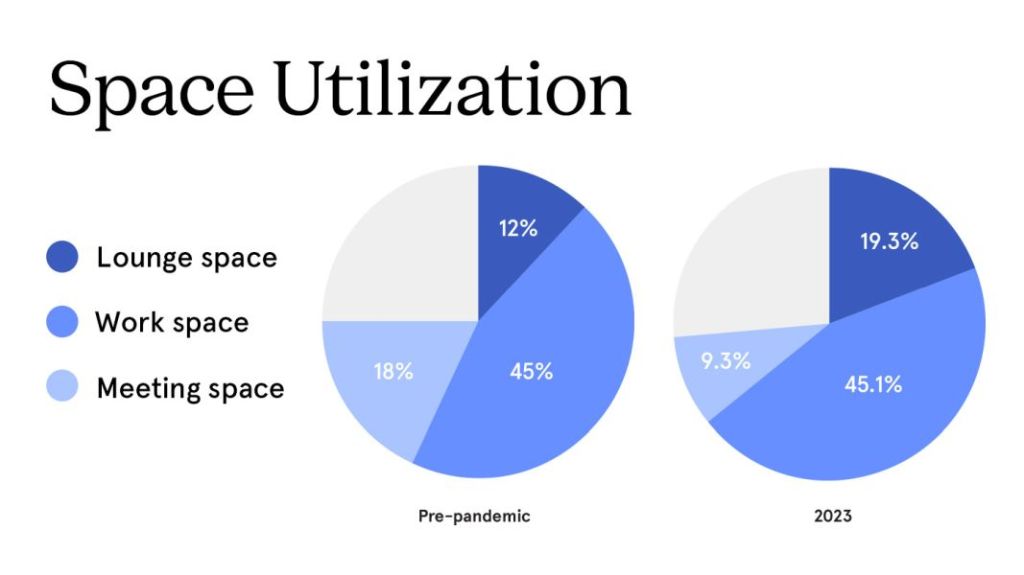What Workers Want Now in Office Design
A close look at today’s top trends, detailed in a new WeWork report.
Out—executive offices and meeting rooms.
In—open floorplans and lounge space.
Those are among the takeaways in WeWork’s first Global Office Trends report.

The 23-page study is based on user surveys and qualitative data from about 3,000 design-related requests from WeWork customers from May 2019 through June 2023. In particular, the global flexible workplace space provider analyzed 25 major enterprise deals since June 2021. It also looked at existing asset locations, new turnkey deals and new customization deals among other factors.
READ ALSO: Where to Find the Bright Side of Office
Part of what WeWork found is not surprising—the traditional office concept has fundamentally and irreversibly changed in recent years, driven by the pandemic and a generational shift in employee’s office expectations and desires. It’s also no surprise that more hybrid and remote work means offices are less densely populated than before the pandemic. So, most employers no longer plan for 100 percent of their workers to be in the office at the same time.
That means they are making their spaces more dynamic and usable across a variety of working needs, making sure to include plenty of room for lounge space. According to WeWork, lounge areas are the parts of an office built for relaxation, collaboration and connection, often furnished with clusters of couches and soft seating, day beds or booths. The company found communal or lounge space designs increased to 19.23 percent in 2023 compared to pre-pandemic. Some of that new space was carved out of the space formerly reused for executive offices. WeWork noted it has seen an 80 percent decrease in requests for executive offices from 2018 to 2022.

The report also describes the rise of non-traditional workspaces as a new go-to amenity for business leaders seeking to boost productivity and company culture. WeWork found 68 percent of non-traditional space requests were aimed at improving productivity and included spaces such as customized board rooms and focus rooms. The report stated 32 percent of requests were for spaces to enhance employee wellbeing and company culture, like “All Hands” spaces and wellness rooms.
Ebbie Wisecarver, global head of design at WeWork, said in a prepared statement the results of the report found there is no one-size-fits-all approach when it comes to creating the modern workplace. She said employees want a repurposed office for collaboration and social interactions while business leaders are increasingly demanding intentionally designed spaces that bolster company culture and productivity.

Wisecarver said as needs and expectations continue to evolve, the “dynamic” office will work best for business leaders looking to future-proof their workplace strategies. She added they should expect to tailor their environments to meet employee demand and enhance their offerings in the years ahead.
Top design requests
WeWork said member requests for pantry space and communal areas doubled since 2021. Some other top takeaways and design requests included:
- Informal settings as available work points so employees can use them as an informal meeting spot or space to catch up with colleagues. They can include a chair and table setup that someone can work from or a seat at dining table, stool at a bar or a booth seat.
- Ergonomic furniture. WeWork found 76 percent of companies requested some height adjustable desking and 80 percent sought upgrades to desks larger than a standard size.
- Low-lux lighting. More than 50 percent of the company requests to WeWork were for linear light fixtures that have a higher performance than legacy dome lights and have a softer, warmer and dimmer glow.
- Non-traditional spaces such as communal areas, wellness spaces, barista bars and shower rooms.
- Investments in productivity-boosting spaces as well, such as training rooms and elevated board rooms as well as focus rooms where employees can find a quiet workplace away from their desks.
- Focus on flexibility by creating reconfigurable layouts with furnishings and space to accommodate a variety of activities.







You must be logged in to post a comment.